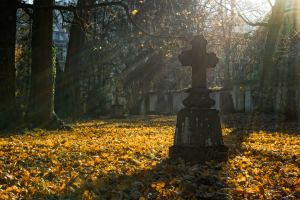Rakowicki Cemetery in Cracow is one of the most important and oldest resting places in Poland. It is a place full of history and culture that is well worth visiting for the upcoming holiday of the dead.
The cemetery was established in 1803 and is a burial place for ordinary citizens of Krakow and distinguished artists of culture, science, representatives of famous families, independence, political and social activists, participants in uprisings and world wars. It has an area of 42 hectares and contains more than 75 thousand graves. In 1976 the cemetery was entered in the register of monuments.
Here you can find beautiful tombstones, chapels and mausoleums that bear witness to different periods in the history of sepulchral art. Its oldest part was designed in the form of a park with a central point - a chapel, behind which the alleys are arranged in the shape of a semicircle. This symbolic, gate-like arrangement was meant to reflect the moment of passing through the gates to eternity.

Many distinguished Poles are buried in this remarkable necropolis. Walking down the main avenue, you will reach the grave of the outstanding painter Jan Matejko, then reach the tombstone of the world-famous actress Helena Modrzejewska. Impressive is the gravestone monument depicting a boy reading a book at a school bench - a character from the play "The Dead Class", designed for him by Tadeusz Kantor, painter, stage designer, director, creator of the Cricot Theater.
It is also worth visiting Avenue of Merit - pantheon of contemporary Polish culture. There you will find the tombs of prominent figures: the painter Jerzy Nowosielski, the founder of the Piwnica pod Baranami cabaret Piotr Skrzynecki with a characteristic bell similar to the one he used during cabaret performances, the singer and poet Marek Grechuta with his bust. In the family tomb rests the poet and Nobel Prize winner for literature, Wislawa Szymborska.

W Avenue of Merit We will also visit the graves of painters Czeslaw Rzepinski, Jonasz Stern, Jerzy Panek, actors: Eugeniusz Fulde, Stanisława Zawiszanka, Jerzy Bińczycki, Barbara Kwiatkowska-Lass, Jerzy Nowak, pianists: Halina Czerny-Stefańska and Jan Hoffman, writer Jerzy Broszkiewicz, poet Tadeusz Śliwiak, writer and translator Maciej Słomczyński, prose writer, publicist and poet Julian Kawalec. The grave of Karol, Emilia and Edmund Wojtyła, the parents and brother of John Paul II, located in the Prandota Street section of the cemetery, is also a frequent destination.
In the oldest part of the cemetery there are also outstanding funerary sculptures, including the Angel of Vengeance (dedicated to the victims of the shelling of Krakow by the Austrians in 1848) and the poignant figure of a grieving woman on the grave of the Falters.
Part of the necropolis is called military cemetery, as it was used for soldier burials. Veterans of the January Uprising, Austro-Hungarian and Russian soldiers killed in World War I, British, Soviet and German soldiers killed in World War II and, above all, soldiers of the Polish Army rest here in separate quarters. Red Army soldiers also have their own quarters. In 1997, remains from the graves of Russians buried under the Barbican were transferred to it.

During the period of All Saints' Day and All Souls' Day, graves in Rakowicki Cemetery are decorated with candles, flowers and candles, creating a beautiful and melancholy mood. It is also a time when families visit the graves of their loved ones, placing flowers and praying for the dead. Rakowicki Cemetery is a place that reminds us of our ancestors and the dead, encouraging reflection and remembrance during this holiday season.